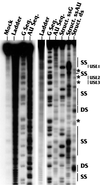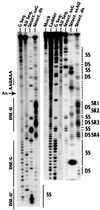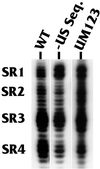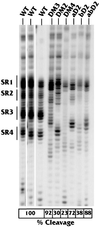Functionally significant secondary structure of the simian virus 40 late polyadenylation signal
- PMID: 10733596
- PMCID: PMC85533
- DOI: 10.1128/MCB.20.8.2926-2932.2000
Functionally significant secondary structure of the simian virus 40 late polyadenylation signal
Abstract
The structure of the highly efficient simian virus 40 late polyadenylation signal (LPA signal) is more complex than those of most known mammalian polyadenylation signals. It contains efficiency elements both upstream and downstream of the AAUAAA region, and the downstream region contains three defined elements (two U-rich elements and one G-rich element) instead of the single U- or GU-rich element found in most polyadenylation signals. Since many reports have indicated that the secondary structure in RNA may play a significant role in RNA processing, we have used nuclease structure analysis techniques to determine the secondary structure of the LPA signal. We find that the LPA signal has a functionally significant secondary structure. Much of the region upstream of AAUAAA is sensitive to single-strand-specific nucleases. The region downstream of AAUAAA has both double- and single-stranded characteristics. Both U-rich elements are predominately sensitive to the double-strand-specific nuclease RNase V(1), while the G-rich element is primarily single stranded. The U-rich element closest to AAUAAA contains four distinct RNase V(1)-sensitive regions, which we have designated structural region 1 (SR1), SR2, SR3, and SR4. Linker scanning mutants in the downstream region were analyzed both for structure and for function by in vitro cleavage analyses. These data show that the ability of the downstream region, particularly SR3, to form double-stranded structures correlates with efficient in vitro cleavage. We discuss the possibility that secondary structure downstream of the AAUAAA may be important for the functions of polyadenylation signals in general.
Figures





Similar articles
-
Definition of the upstream efficiency element of the simian virus 40 late polyadenylation signal by using in vitro analyses.Mol Cell Biol. 1992 Dec;12(12):5386-93. doi: 10.1128/mcb.12.12.5386-5393.1992. Mol Cell Biol. 1992. PMID: 1333042 Free PMC article.
-
The 64-kilodalton subunit of the CstF polyadenylation factor binds to pre-mRNAs downstream of the cleavage site and influences cleavage site location.Mol Cell Biol. 1994 Oct;14(10):6647-54. doi: 10.1128/mcb.14.10.6647-6654.1994. Mol Cell Biol. 1994. PMID: 7935383 Free PMC article.
-
Auxiliary downstream elements are required for efficient polyadenylation of mammalian pre-mRNAs.Nucleic Acids Res. 1998 Jun 15;26(12):2891-8. doi: 10.1093/nar/26.12.2891. Nucleic Acids Res. 1998. PMID: 9611233 Free PMC article.
-
Downstream elements of mammalian pre-mRNA polyadenylation signals: primary, secondary and higher-order structures.Nucleic Acids Res. 2003 Mar 1;31(5):1375-86. doi: 10.1093/nar/gkg241. Nucleic Acids Res. 2003. PMID: 12595544 Free PMC article. Review.
-
Transcription termination and polyadenylation in retroviruses.Microbiol Rev. 1993 Sep;57(3):511-21. doi: 10.1128/mr.57.3.511-521.1993. Microbiol Rev. 1993. PMID: 7902524 Free PMC article. Review.
Cited by
-
Enhanced Transgene Expression by Optimization of Poly A in Transfected CHO Cells.Front Bioeng Biotechnol. 2022 Jan 24;10:722722. doi: 10.3389/fbioe.2022.722722. eCollection 2022. Front Bioeng Biotechnol. 2022. PMID: 35141210 Free PMC article.
-
Means to an end: mechanisms of alternative polyadenylation of messenger RNA precursors.Wiley Interdiscip Rev RNA. 2014 Mar-Apr;5(2):183-96. doi: 10.1002/wrna.1206. Epub 2013 Nov 14. Wiley Interdiscip Rev RNA. 2014. PMID: 24243805 Free PMC article. Review.
-
A downstream polyadenylation element in human papillomavirus type 16 L2 encodes multiple GGG motifs and interacts with hnRNP H.J Virol. 2005 Jul;79(14):9254-69. doi: 10.1128/JVI.79.14.9254-9269.2005. J Virol. 2005. PMID: 15994820 Free PMC article.
-
Distance-dependent processing of adeno-associated virus type 5 RNA is controlled by 5' exon definition.J Virol. 2007 Aug;81(15):7974-84. doi: 10.1128/JVI.00714-07. Epub 2007 May 16. J Virol. 2007. PMID: 17507471 Free PMC article.
-
Transactivation of a viral target gene by herpes simplex virus ICP27 is posttranscriptional and does not require the endogenous promoter or polyadenylation site.J Virol. 2003 Sep;77(18):9872-84. doi: 10.1128/jvi.77.18.9872-9884.2003. J Virol. 2003. PMID: 12941897 Free PMC article.
References
-
- Ahmed Y F, Gilmartin G M, Hanly S M, Nevins J R, Greene W C. The HTLV-I rex response element mediates a novel form of mRNA polyadenylation. Cell. 1991;64:727–737. - PubMed
Publication types
MeSH terms
Substances
Grants and funding
LinkOut - more resources
Full Text Sources
Other Literature Sources
Miscellaneous
